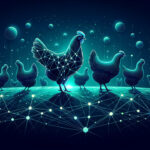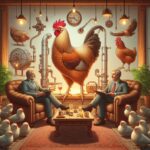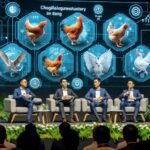The poultry industry is undergoing a significant transformation, thanks to the adoption of Internet of Things (IoT) technologies. As the demand for poultry products increases, so does the need for efficient, sustainable, and innovative farming practices. IoT in poultry farming offers a solution by enabling real-time monitoring, data collection, and automation, ensuring better decision-making and enhanced productivity. This blog dives into the potential of IoT in revolutionizing poultry farming, explaining its applications, benefits, and how it connects farms to a future of smart, data-driven operations.
The Role of IoT in Poultry Management
IoT technology leverages connected devices to monitor various parameters critical to poultry farming. From environmental conditions to bird health, IoT sensors gather data in real time, providing farmers with actionable insights. This interconnected ecosystem eliminates guesswork and improves decision-making. For example, IoT-enabled temperature and humidity sensors in poultry houses ensure optimal living conditions for birds, reducing stress and improving growth rates. Data from these sensors can trigger automatic adjustments to ventilation systems, ensuring a stable environment without human intervention.
Enhancing Efficiency Through Automation
One of the key advantages of IoT is its ability to automate repetitive tasks. Smart feeders and drinkers, integrated with IoT systems, dispense precise quantities based on bird requirements, minimizing waste and ensuring adequate nutrition. Similarly, automated lighting systems adjust light intensity and duration to mimic natural patterns, promoting better growth and laying performance. These automated solutions save time and labor while increasing efficiency, allowing farmers to focus on strategic operations rather than daily maintenance tasks.
Improving Bird Health and Welfare
IoT devices play a vital role in maintaining bird health and welfare. Wearable sensors and cameras monitor bird activity, feeding habits, and health indicators. Any deviations from normal behavior are flagged, enabling early detection of potential issues like disease outbreaks. IoT solutions also track individual bird data, helping farmers implement personalized care plans. This proactive approach reduces mortality rates, enhances productivity, and ensures a higher quality of poultry products.
Data-Driven Decision Making in Poultry Farming
The true power of IoT lies in its ability to turn data into actionable insights. By analyzing data collected from IoT devices, farmers can identify trends, optimize processes, and predict outcomes. For instance, predictive analytics can forecast feed requirements, reducing overstocking or shortages. Similarly, historical data on environmental conditions can help farmers prepare for seasonal changes, ensuring consistency in production.
Sustainability and Resource Conservation
Sustainability is a growing concern in poultry farming. IoT contributes to eco-friendly practices by optimizing resource usage and minimizing waste. Smart water management systems detect leaks and monitor consumption, conserving water and reducing costs. IoT-based waste management solutions convert poultry litter into bioenergy, promoting circular economy practices and reducing environmental impact.
Challenges and Adoption of IoT in Poultry Farming
Despite its benefits, IoT adoption in poultry farming is not without challenges. Initial setup costs and the need for technical expertise can be barriers for smaller farms. However, as IoT devices become more affordable and user-friendly, these obstacles are gradually being overcome. Training programs and partnerships with technology providers can bridge knowledge gaps, ensuring that farmers maximize the potential of IoT solutions.
Conclusion
IoT is no longer a futuristic concept; it is a practical tool reshaping poultry farming today. By enabling real-time monitoring, automation, and data-driven decision-making, IoT empowers farmers to operate more efficiently, sustainably, and profitably. For poultry industry professionals looking to stay ahead in a competitive market, embracing IoT is not just an option—it’s a necessity. As the industry evolves, IoT will continue to play a pivotal role in connecting farms to the future, ensuring a smarter, more innovative approach to poultry farming.






